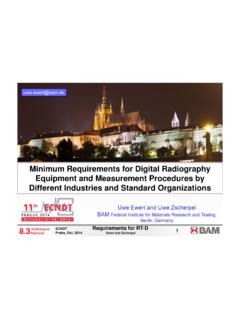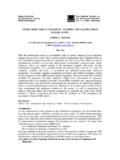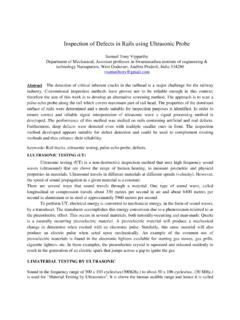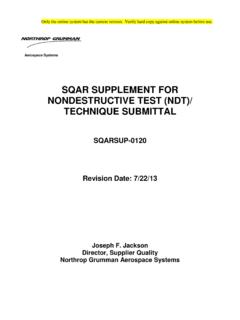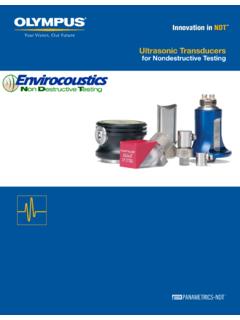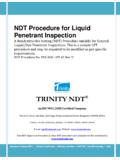Transcription of Choosing the Proper Nondestructive Testing Techniques
1 Choosing the Proper Nondestructive Testing Techniques Donald N. Bugden Magnetic Analysis Corporation, Mt. Vernon, NY, USA Phone: (914) 699-9450, Fax: (914) 699-9837; e-mail: Abstract This paper will concentrate on the three Nondestructive Testing methods namely, eddy current, ultrasonic and flux leakage, which are the predominant methods used in the steel tube industry for flaw detection, while recognizing the role of pressure related or mechanical proof Testing . The advantages and disadvantages of the three methods are reviewed.
2 In the past, this type of comparison was made when Choosing which of the three methods to apply, but as demands for quality increase and multiple methods are used, it has become necessary to combine and locate these methods in the manufacturing process so as to produce a complimentary and flexible system, rather than mere redundancy. One outcome that seems to come to light from this discussion is whether the Nondestructive test procedures that pertain to steel tubing, and which tend to be exclusive for the various methods, and thus encourage redundancy rather than synergy, should be reviewed and subsequently revised.
3 Keywords: Nondestructive Testing , eddy-current, ultrasound, flux leakage, tube, defect, flaw, API, ASTM, DIN Tubing Considerations The tube buyer requires tubing that will perform as required, so as to conform to any applicable regulations and diminish the specter of product warranty or personal liability claims. He will attempt to satisfy this requirement as economically as possible. Some of the issues that must be considered by the buyer are: The end use of the tubing Grade or alloy chosen Seamless or welded Cold finished or not Mandatory Nondestructive test specifications Documentation Supplements to Flaw Detection: Grade mix protection Demagnetizing Dimensional measurement Proof Testing Mechanical sampling Typically, the types of tubing chosen by the end user will be based upon considerations that take precedence over the eventual Nondestructive test methods chosen.
4 Since this first choice has considerable impact upon the effectiveness of the method that is eventually applied, there is a need to factor in the Nondestructive test options early in the decision process. Since the tube buyer depends to a great extent upon the advice of the tube manufacturer, the increasing interest and level of sophistication of Nondestructive personnel at the tube mill in the subtleties of the various methods is important, and must be supported by the manufacturers of Nondestructive test systems. The major needs of the tube manufacturer derived from the tube buyer can be listed in the following way: Compete in quality and price Meet industry and customer specifications Maintain maximum yield Limit Testing cost Satisfy diverse clientele Choosing the Proper NDT technique As can be seen from the abbreviated list in Table 1, which is far from being all-inclusive, we are already confronted with a huge combination of variables.
5 The choices made, in terms of product parameters, have a profound influence upon which type of product deviations are likely to occur. Furthermore, these variables must be reconciled with the capabilities of the various methods that are listed, in a general way, in Table 2. Except in those cases where an elaborate request for quotation is prepared, - usually limited to large and expensive systems many of the factors listed previously that greatly influence the long term costs of providing Nondestructive Testing are not taken into account in the buy decision.
6 Very often the tube manufacturer looks for the lowest capital investment that will comply with the NDT Specification chosen by the tube buyer. Although this may sometimes be the best decision, there are a number of questions that the tube manufacturer should consider before making that assumption. First of all, even if the most appropriate Nondestructive test procedure seems to be specified, which is not always the case, it will not guarantee the detection of all natural defects that may cause a service failure. Since the tube manufacturer will feel some impact from the failure, if not in the case at hand perhaps in the loss of a customer, the choice of NDT Specification should be evaluated with the types of defects that are known to occur, as well as the strengths and weaknesses of the various Nondestructive test methods in mind.
7 This is especially true since the various specifications pertaining to the Testing of tubing leave considerable leeway in choice and application of method. Even when a specific method is called out, certain test parameters may be left to the tube manufacturer, or can be negotiated with the tube buyer. A second important consideration is the effect on yield of the method or the particular apparatus within a method that is chosen. This can have a dramatic effect on reject rates. The ideal method or combination of methods would reject only those conditions that will result in service failure.
8 Although this ideal cannot be totally achieved, the extra investment in improved systems that are becoming available may very well show a very short return on investment from increased yields because of the test equipment s ability to come close to making the important distinction between detrimental and innocuous deviations. Another set of decisions with considerable cost implications is where to place the Nondestructive test system in the production flow. The simplistic answer would be to place the system as close as possible to the operation that will be the last source for defects.
9 In the case of a welded tube mill, where the tubing is used in an as welded condition, a fairly common situation, this solution is achievable and the choice of a method, for instance, eddy current, may be clear-cut. However, even here complications can arise. If the specification calls for two methods, as may be the case for gas distribution lines, and hydrostatic Testing is chosen as the second method, the specification may require that the Nondestructive test be done after the hydrostatic on the premise that the hydrostatic may open up pasty or incomplete welds.
10 The same concern would apply in a structural welded tube mill set up to produce either rounds, as a final product, or to be fed into forming rolls down steam in the mill where it is formed into shapes. Here again, defects that are not detected immediately after welding may be enlarged by the cold forming, and the test station should therefore follow the forming operation. As the number of operations where defects can be created increases, the potential sites for Nondestructive test stations expand accordingly, and the benefit of multiple tests at different locations needs to be explored.


